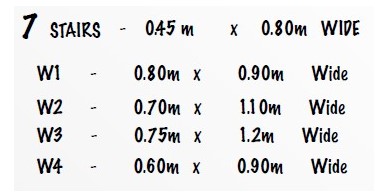Installing new carpet on your stairs can significantly enhance the look and feel of your home. But before you head out and choose the perfect material, precise measurements are crucial. In the UK, where pile direction (the way the carpet fibres lie) plays a vital role in aesthetics, accurate measurements become even more important. This guide will walk you through the process of measuring your stairs for carpet installation, ensuring a seamless and professional finish.
In the UK, where quality and craftsmanship are highly valued, taking accurate measurements is essential for a professional-looking finish. This guide will walk you through the process of measuring stairs for carpet installation, ensuring that you achieve a flawless result.
Understanding Pile Direction and Why it Matters
Carpet pile direction refers to the way the fibres lie, creating a subtle variation in colour and texture depending on the angle of light. In the UK, it’s customary to have the pile running downwards on the stairs, creating a smooth flow from top to bottom. Accurate measurements ensure the carpet is cut with the pile direction in mind, resulting in a visually appealing and uniform installation.
Measuring stairs accurately is crucial for several reasons. Firstly, it ensures that you purchase the correct amount of carpet, saving you time and money. Secondly, accurate measurements guarantee that the carpet fits neatly and securely on each step, minimizing the risk of trips or falls. Finally, precise measurements enable carpet installers to cut the carpet with precision, resulting in a professional-looking finish.
Tools and Materials You’ll Need
To measure stairs for carpet installation, you will need the following tools:
- Tape Measure: Essential for measuring the dimensions of each stair tread accurately.
- Pen and Paper: To record your measurements for reference during carpet selection and installation.
- Safety Equipment: Wear appropriate footwear and use a stable ladder if needed to ensure safety during the measurement process.
Preparing for Measurement:
Clearing the Stairs
Start by clearing the stairs of any objects, such as furniture or rugs, that may obstruct your measurements. If there is existing carpeting on the stairs, remove it carefully to expose the underlying surface.
Ensuring Proper Lighting and Accessibility
Good lighting is essential for accurate measurements, so make sure the area is well-lit before you begin. Additionally, ensure that you have easy access to all parts of the staircase, including any curved or angled sections.
Taking Necessary Safety Precautions
Before you start measuring, take the necessary safety precautions to prevent accidents. Wear sturdy footwear with good traction to avoid slipping, especially if the stairs are made of hardwood or other slippery materials. If you need to use a ladder to reach higher areas of the staircase, make sure it is stable and secure before climbing.
Step-by-Step Measurement Process:
Measuring the Width of Each Stair:
Start by measuring the width of each stair tread. Place the measuring tape at the widest point of the tread, usually from one side to the other, and record the measurement in inches or centimeters. Repeat this process for each stair, ensuring consistency.
Measuring the Depth of Each Stair:
Next, measure the depth of each stair tread. Place the measuring tape from the back of the tread to the front nosing, ensuring it follows the contour of the step. Record this measurement for each stair, as they may vary slightly.
Counting the Number of Stairs:
Count the number of stairs in your staircase, including any landings or platforms. This will give you the total number of steps that need to be covered with carpet.
Calculating Total Carpet Required:
- Square Footage Method: Multiply the width by the depth of each stair to calculate the square footage of the carpet needed for one step. Then, multiply this by the total number of stairs to determine the total square footage required.
- Length Method: Add the depth of each stair to the width of the previous one to calculate the total length of carpet needed. Multiply this by the number of stairs to get the total length required.

Image source: tapi.co.uk
Things to remember
- Always measure from the top of the stairs downwards, as this is the way the pile direction will go
- Curved stairs must be measured individually as each step may be different!
- Measure the width and depth of any doorways on your landing and hallway
- Don’t forget to measure any dropbacks, alcoves, or any funny little spaces that don’t follow the natural shape of the stairs, landing, or hallway
- Take some measurements wall to wall across your landing and stairway, as your walls may not be completely parallel
- The part of the stair you step on is called the tread, the edge is called the nose, and the vertical part is called the riser
- If you have a half landing, make sure to measure the length and width, as well as the next downward step’s tread
- Take plenty of photos!
Dealing with Complex Staircases:
Some staircases may have unique features that require special consideration when measuring for carpets.
Curved or Spiral Stairs:
For curved or spiral staircases, measure the widest and deepest points of each step along the curve. Take multiple measurements to ensure accuracy, as these stairs can vary in shape.
L-shaped or U-shaped Stairs:
Measure each section of the staircase separately, treating each landing or turn as a separate set of stairs. Follow the same process for measuring width and depth as with straight stairs.
Angled or Winder Stairs:
Angled or winder stairs may have irregular shapes, making them more challenging to measure. Take precise measurements at the narrowest and widest points of each step, and consider consulting a professional for accurate measurements.

Image source: tapi.co.uk
Considering Carpet Pattern and Direction:
When installing carpet on stairs, it’s essential to consider the pattern and direction of the carpet fibers to achieve a cohesive look.
Ensuring Consistency in Pattern Alignment:
If your carpet has a pattern, ensure that it lines up consistently across each step. This may require additional carpet to match patterns correctly.
Determining Carpet Direction:
Decide whether you want the carpet fibers to run parallel or perpendicular to the staircase. This choice can affect the appearance and wear of the carpet over time.
Accounting for Pattern Repeats:
When measuring for patterned carpet, consider the repeat of the pattern and adjust your measurements accordingly to ensure a seamless installation.
Factors Affecting Carpet Measurement:
Several factors can impact the amount of carpet needed for your staircase, beyond just the dimensions of the steps.
Padding and Underlay Considerations:
Factor in the thickness of the carpet padding or underlay, as this will add to the overall height of the carpet on each step.
Trim and Overhang Adjustments:
Take into account any trim or overhangs on the stairs that may affect the placement and fit of the carpet.
Extra Material for Pattern Matching:
If your carpet has a repeating pattern, you may need to purchase additional material to ensure the pattern matches seamlessly across each step.
Common Mistakes to Avoid:
To ensure accurate measurements and a successful carpet installation, avoid these common pitfalls:
Not Measuring Each Step Individually:
It’s crucial to measure each step individually, as even small variations in size can affect the fit of the carpet.
Ignoring Carpet Direction and Pattern:
Neglecting to consider the direction and pattern of the carpet fibers can result in a disjointed appearance on the stairs.
Underestimating or Overestimating Material:
Failing to calculate the correct amount of carpet needed can lead to shortages or excess material, resulting in additional costs and wasted resources.
Conclusion:
Accurately measuring your stairs for carpet is essential for a successful installation. By following the step-by-step process outlined in this guide and considering factors such as carpet pattern and direction, you can ensure a professional-looking finish that enhances the beauty and functionality of your staircase.
If you encounter complex staircases or are unsure about any aspect of the measurement process, don’t hesitate to seek guidance from a professional carpet installer. With careful planning and attention to detail, you can transform your staircase with the luxurious comfort of carpet.
Frequently Asked Questions (FAQs)
To calculate the carpet area for stairs, measure the width and depth of each step. Multiply the width by the depth to get the area of one step. Then, multiply this by the total number of steps. Add the landing area if applicable. Don’t forget to account for any irregular shapes or landings.
For 12 stairs in the UK, you’ll need to measure the width and depth of each step. Then, multiply the total area of one step by 12 to get the total carpet needed. Make sure to add extra for trimming and fitting.
To measure the hall, stairs, and landing for the carpet, start by measuring the length and width of each area separately. For the stairs, measure each step’s width and depth. Include any landings in your measurements. Multiply the length by the width for each area, then sum up all the areas to get the total carpet needed.
To calculate the carpet needed for 13 steps, measure the width and depth of each step. Multiply the area of one step by 13 to get the total area required. Remember to include any landings and add extra for trimming and fitting.
